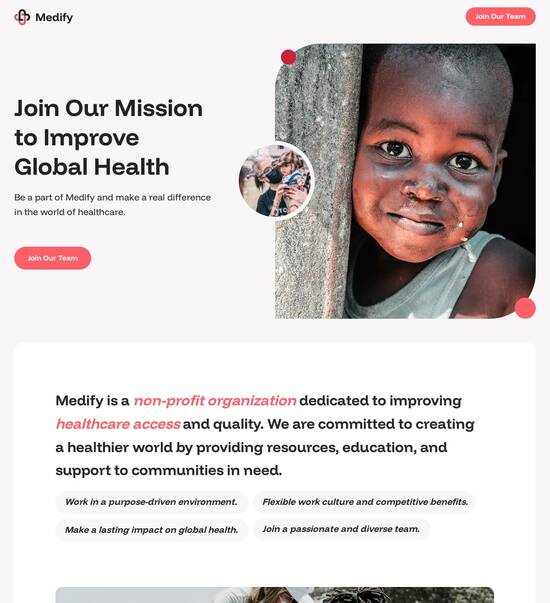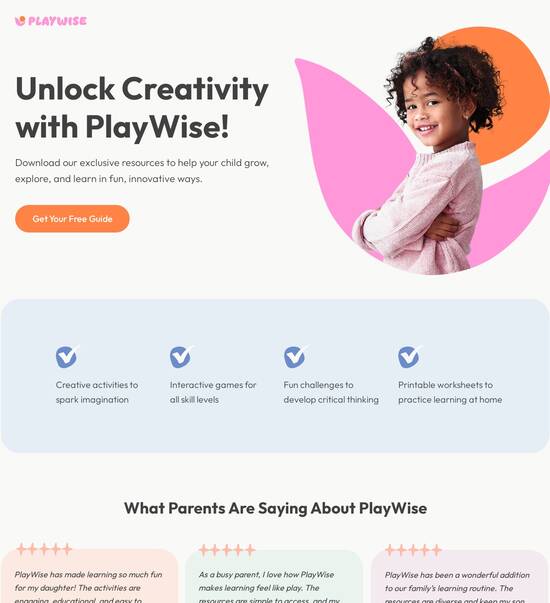
Onboarding page template for Internal Audit
Explore Similar TemplatesAbout template
Making landing pages is easy with Instapage. Find your onboarding page template for Internal Audit and easily polish it with our powerful editor.
Recommended templates

Easy to build without coding
With the intuitive drag-and-drop builder, anyone on your team can create high-converting pages without any knowledge of code or design. Make enhancements to your landing page with custom widgets using Javascript, HTML/CSS, or third-party scripts.

Multiple layouts for any industry and goal
Select from 500+ landing page layouts built to boost conversions across industry-specific scenarios. Customize them by adjusting fonts, adding images, and generating on-brand content with the AI assistant. Quickly scale with Instablocks® and Global Blocks that you can save, reuse, and update globally.

Loads fast and looks polished on any device
Every template is responsive, which means they present professionally on any device and load blazingly fast with our Thor Render Engine. You can also power them up with Google AMP technology to deliver an unparalleled mobile experience and drive higher conversions.

Robust analytics & experimentation
Get real-time updates and reporting across all your devices, showing the number of visitors, conversions, cost-per-visitor, and cost-per-lead. Launch AI-powered experiments, run A/B tests, and use heatmaps to analyze user behavior, then optimize your landing page to maximize conversions.







Easy to build without coding
With the intuitive drag-and-drop builder, anyone on your team can create high-converting pages without any knowledge of code or design. Make enhancements to your landing page with custom widgets using Javascript, HTML/CSS, or third-party scripts.
Multiple layouts for any industry and goal
Select from 500+ landing page layouts built to boost conversions across industry-specific scenarios. Customize them by adjusting fonts, adding images, and generating on-brand content with the AI assistant. Quickly scale with Instablocks® and Global Blocks that you can save, reuse, and update globally.
Loads fast and looks polished on any device
Every template is responsive, which means they present professionally on any device and load blazingly fast with our Thor Render Engine.
Robust analytics & experimentation
Get real-time updates and reporting across all your devices, showing the number of visitors, conversions, cost-per-visitor, and cost-per-lead. Launch AI-powered experiments, run A/B tests, and use heatmaps to analyze user behavior, then optimize your landing page to maximize conversions.
All the features you need to build lead-generating landing pages
Explore more featuresLearn how to build top-performing landing pages for any goal
FAQs
Leading the way in building high-performing landing pages





A comprehensive guide to crafting an onboarding page template for internal audit professionals
Creating an effective onboarding page template for internal audit professionals is paramount for enhancing workflow and communication efficiency. Instapage's robust tools enable you to design high-converting landing pages that cater specifically to the needs of internal audit teams, ensuring a streamlined onboarding process. By leveraging the platform's templates and optimization features, businesses can customize their approach to fit their unique needs.
Understanding the Importance of Onboarding for Internal Audit Professionals
The onboarding process is crucial for internal audit professionals, as it sets the foundation for their engagement and productivity within the organization. A well-structured onboarding page can help familiarize new hires with company policies, resources, and expectations, enabling them to effectively navigate their roles. Crafting a succinct yet comprehensive onboarding page template involves considering the unique requirements and challenges faced by internal audit teams.
- Clarity in company policies: Ensure that the onboarding page outlines company policies relevant to internal audits, guiding professionals in compliance and procedural standards.
- Access to training materials: Include links to training resources which can expedite the learning curve for new hires and enhance their understanding of internal audit principles.
- Introduction to team members: Personalize the onboarding experience by introducing new team members to their colleagues, fostering a sense of community and collaboration.
Step 1: Designing an Engaging Onboarding Page Template
The first step in creating an onboarding page template is to utilize Instapage's intuitive design tools to build an engaging layout. Begin by selecting a suitable template that aligns with your brand messaging and internal audit requirements. Ensure the use of visuals and clear calls-to-action to enhance user interaction.
Step 2: Incorporating Essential Content
With the template in place, focus on incorporating essential content that caters to the needs of internal audit professionals. This can include key performance indicators and audit frameworks relevant to the team's objectives.
- Key performance indicators (KPIs): Clearly outline the KPIs that will be critical to the internal audit process, allowing new hires to align their focus.
- Audit frameworks: Include overviews of the internal audit frameworks used in your organization to equip new hires with foundational knowledge.
- FAQs about roles: Provide a section with FAQs pertaining to the roles and responsibilities to set clear expectations from the start.
Step 3: Utilizing Optimization Features for Continuous Improvement
Finally, leverage Instapage's optimization features, such as A/B testing and heatmaps, to continuously refine the onboarding page template. Utilizing feedback and performance metrics will ensure that your content remains relevant and engaging for all new internal audit hires.
- A/B testing: Experiment with different content arrangements to determine the most effective format for new hires.
- Heatmaps: Analyze user interaction to identify areas of interest and improve navigation.
- Feedback survey: Implement a feedback survey to gather insights on the onboarding process directly from new employees.
By following these structured steps, internal audit professionals can facilitate a smooth onboarding process that enhances teams' performance and integration.
Start creating your onboarding page template using Instapage today. Sign up for a free trial and explore the powerful features that will elevate your internal audit team's efficiency.
People also ask about Onboarding page template for Internal Audit professionals
Unlocking the full potential of onboarding page templates for internal audit professionals
Understanding the onboarding landscape in internal audit
The onboarding landscape within internal audit is crucial for establishing a foundation of compliance, efficiency, and collaboration. A well-structured onboarding process not only welcomes new auditors but also significantly impacts team performance and adherence to regulations. Effective onboarding can reduce the time it takes for new hires to become productive, ensuring that they understand their roles, responsibilities, and the overall audit environment. With an increasingly complex regulatory environment, equipping new employees with the necessary knowledge and resources is more essential than ever.
For internal audit professionals, the onboarding process sets the stage for long-term success. It is critical that these individuals are trained adequately to navigate their responsibilities, which often include assessing risk, evaluating internal controls, and ensuring compliance with laws and regulations. A structured onboarding process significantly impacts their performance, shaping how they approach their auditing tasks and integrate into the company culture.
Importance of clear expectations: A defined onboarding process helps clarify job expectations for auditors.
Connection to compliance: Effective onboarding connects new hires to the organization's compliance objectives.
Framework for success: A structured onboarding approach provides a comprehensive framework for ongoing professional development.
Defining internal audit professionals
Internal audit professionals are tasked with evaluating and improving the effectiveness of risk management, control, and governance processes. Their key responsibilities encompass not just the execution of audits but also the communication of findings, recommendations, and best practices to senior management. They play a vital role in safeguarding the organization against risks, ensuring compliance with applicable regulations, and enhancing business operations.
The competencies required for an internal audit career often include strong analytical skills, attention to detail, and effective communication abilities. Many professionals hold degrees in accounting, finance, or business administration, and many pursue certifications such as Certified Internal Auditor (CIA) or Certified Public Accountant (CPA). As they progress in their careers, internal auditors typically take on greater responsibility, mentoring junior staff and leading audit engagements. Understanding the typical career path helps organizations design onboarding programs that cater to their employees' expected growth trajectories.
Essential elements of an effective onboarding page template
Creating an effective onboarding page template for internal audit professionals requires a strategic approach. First, it should include detailed employee profiles that tailor the onboarding experience based on the role of the new hire, whether entry-level, mid-career, or senior auditors. This personalized approach allows organizations to better address the unique needs and expectations of different roles, enhancing the learning experience and engagement.
Moreover, making the onboarding page digitally accessible is crucial. With the increased prevalence of remote work, ensuring that the onboarding experience is mobile-friendly and interactive can significantly improve engagement. Utilizing multimedia elements such as videos, interactive checklists, and quizzes can make the onboarding process more enjoyable and effective.
User Roles: Clearly define onboarding pathways based on different audit roles to provide tailored content.
Interactive Tools: Include multimedia elements such as videos and quizzes to enhance learning.
Feedback Mechanism: Incorporate a section for new hires to provide feedback on their onboarding experience.
Offer letter integration
Integrating offer letters with onboarding templates is vital to maintaining clarity and seamless transitions. Clear correspondence between an offer letter and the onboarding template ensures that new hires fully understand their roles, responsibilities, and what to expect during their initial days. Including example snippets from standard offer letters can help align expectations with actual onboarding activities, enhancing overall coherence.
A well-designed onboarding page can include sections that connect the content of the offer letter to specific onboarding activities. For instance, if an offer letter outlines specific training sessions or performance expectations, these can be highlighted in the onboarding template, thus providing a clear path for new employees to follow.
The onboarding process: Stages and checklists
An effective onboarding process can be divided into several stages: pre-boarding, orientation, training and development, and integration. Each of these stages plays a vital role in ensuring new audit professionals are well-prepared to contribute to their teams. The pre-boarding stage prepares new hires before their start date, ensuring necessary documentation, equipment, and training materials are ready. This reduces first-day anxiety and allows employees to hit the ground running.
During orientation, the focus shifts to introducing new hires to the company culture and guiding them through essential policies and procedures. This stage plays a crucial role in creating a positive first impression and making employees feel welcomed. Following orientation, training and development offer tailored skills enhancement through specific programs, while integration involves connecting new hires with mentors and engaging in team-building activities that foster collaboration.
Pre-boarding Checklist
Include documentation requirements, equipment allocation, and training material preparation.
Orientation Checklist
Outline introductions, company policies overview, and explanation of workplace etiquette.
Training Checklist
Identify courses, certifications, and practical assessments relevant to the auditors’ roles.
Integration Checklist
Incorporate mentorship programs, social connection opportunities, and team-building exercises.
Customizing onboarding templates for internal audit teams
When customizing onboarding templates, it is important to consider the specific needs and requirements of various audit roles. For instance, the onboarding for auditors will likely differ from that designed for data analysts or compliance officers. Each role carries distinct responsibilities, which should be reflected in the onboarding content and associated activities. Developing targeted templates facilitates a smoother transition into the company while maximizing retention of necessary skills and knowledge.
Furthermore, providing user-generated customization options can further enhance the onboarding experience. Allowing for employee feedback enables organizations to continuously improve their templates based on the experiences of recent hires. Additionally, utilizing analytics to modify content based on engagement metrics will ensure the onboarding material remains relevant and effective in addressing the evolving needs of the internal audit profession.
Technological innovations in onboarding processes
Incorporating digital tools into the onboarding process can greatly enhance the overall experience for new hires. For instance, Learning Management Systems (LMS) can deliver training modules electronically, allowing auditors to access educational resources whenever convenient. This flexibility is essential in today’s fast-paced environment, as it empowers employees to learn at their own pace, fitting training around their schedules.
Another innovation worth considering is the gamification of onboarding steps. By transforming mundane tasks into engaging activities, organizations can spur new hires’ motivation to complete their training. Implementing elements such as quizzes, rewards, and achievement badges can make the onboarding journey more enjoyable while fostering a competitive spirit among team members.
Fostering engagement and retention through onboarding
Creating an engaging onboarding experience is fundamental to establishing a sense of belonging from day one. A warm welcome message from the leadership team can set a positive tone and make new hires feel valued. Additionally, introductory videos that explain the company’s mission and values can foster a deeper connection to the organizational culture, leading to improved morale and engagement among employees.
To maintain this engagement, encouraging connections among team members and other departments is essential. Facilitating informal meet-and-greets, social gatherings, or group activities helps build relationships, making integration smoother. Research shows that employee satisfaction and retention correlate positively with effective onboarding practices, indicating that organizations should prioritize their onboarding strategies.
Evaluating the effectiveness of onboarding programs
Regular evaluation of onboarding programs is essential to ensuring their effectiveness. Organizations can measure onboarding success using specific key performance indicators (KPIs), which provide actionable insights into the onboarding process. Metrics such as time-to-productivity, employee feedback ratings, and retention rates offer concrete data that can inform future improvements and adjustments.
Additionally, conducting employee feedback surveys further assists in assessing satisfaction and identifying areas for growth. These surveys can reveal gaps in the onboarding experience and suggest areas that need refinement, contributing to a culture of continuous improvement. Organizations that utilize data analysis effectively can tailor their onboarding processes to align with the specific needs and expectations of their internal audit professionals.
Best practices for developing onboarding page templates
Incorporating best practices into the design of onboarding page templates can significantly enhance their effectiveness. Prioritizing user experience is paramount; this includes creating visually appealing layouts, ensuring easy navigation, and establishing a clear information hierarchy. By maintaining a user-friendly interface, organizations can prevent new hires from feeling overwhelmed, enabling them to focus on learning.
Keeping content regularly updated and relevant to industry standards is also a vital best practice. This ensures that new hires are exposed to the most accurate and pertinent information during their onboarding journey. Regularly reviewing templates and integrating feedback from existing employees can enrich the quality of the material, leading to improved onboarding outcomes.
Future trends in onboarding for internal audit professionals
As businesses adapt to remote and hybrid work environments, onboarding processes must remain effective despite these changes. One emerging trend is the integration of virtual onboarding tools that facilitate seamless experiences for remote employees. Organizations now utilize remote training sessions, digital resource centers, and virtual team-building activities to foster connection and provide comprehensive onboarding experiences, regardless of physical location.
Additionally, as regulations and technology in audit practices evolve, the skill sets required by internal audit professionals continually change. Onboarding programs that emphasize continuous learning opportunities, such as access to ongoing training resources and professional development conferences, will prepare new hires to stay current in their field. By emphasizing lifelong learning and the importance of professional growth from the start, organizations can develop highly skilled internal auditors, thereby strengthening their compliance and governance structures.
Ready to skyrocket conversions?
Supercharge your ad campaigns with high-performing landing pages
Get started














